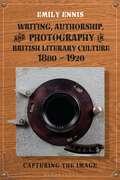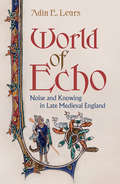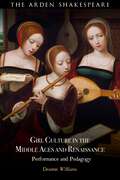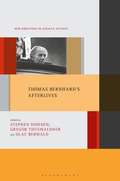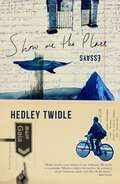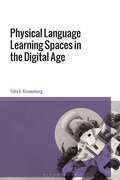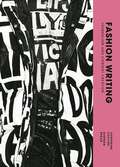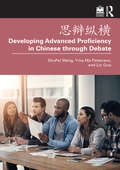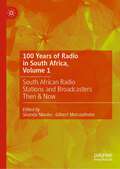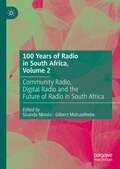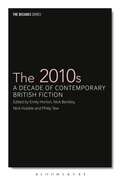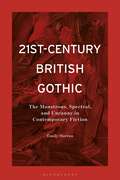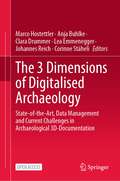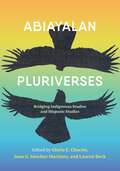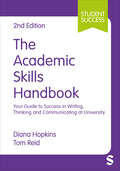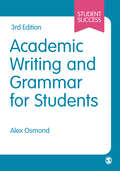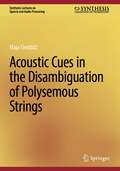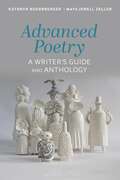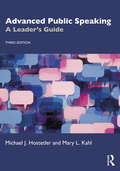- Table View
- List View
Writing, Authorship and Photography in British Literary Culture, 1880 - 1920: Capturing the Image
by Emily EnnisAt the turn of the 20th century, printing and photographic technologies evolved rapidly, leading to the birth of mass media and the rise of the amateur photographer. Demonstrating how this development happened symbiotically with great changes in the shape of British literature, Writing, Authorship and Photography in British Literary Culture, 1880-1920 explores this co-evolution, showing that as both writing and photography became tools of mass dissemination, literary writers were forced to re-evaluate their professional and personal identities. Focusing on four key authors-Thomas Hardy, Bram Stoker, Joseph Conrad and Virginia Woolf-each of which had their own private and professional connections to photographs, this book offers valuable historical contexts for contemporary cultural developments and anxieties. At first establishing the authors' response to developing technologies through their non-fiction, personal correspondences and working drafts, Ennis moves on to examine how their perceptions of photography extend into their major works of fiction: A Laodicean, Dracula, The Secret Agent, The Inheritors and The Voyage Out. Reflecting on the first 'graphic revolution' in a world where text and image are now reproduced digitally and circulated en masse and online, Ennis redirects our attention to when image and text appeared alongside each other for the first time and the crises this sparked for authors: how they would respond to increasingly photographic depictions of everyday life, and in turn, how their writing adapted to a distinctly visual mass media.
World of Echo: Noise and Knowing in Late Medieval England
by Adin E. LearsBetween late antiquity and the fifteenth century, theologians, philosophers, and poets struggled to articulate the correct relationship between sound and sense, creating taxonomies of sounds based on their capacity to carry meaning. In World of Echo, Adin E. Lears traces how medieval thinkers adopted the concept of noise as a mode of lay understanding grounded in the body and the senses. With a broadly interdisciplinary approach, Lears examines a range of literary genres to highlight the poetic and social effects of this vibrant discourse, offering close readings of works by Geoffrey Chaucer and William Langland, as well as the mystics Richard Rolle and Margery Kempe. Each of these writers embraced an embodied experience of language resistant to clear articulation, even as their work reflects inherited anxieties about the appeal of such sensations. A preoccupation with the sound of language emerged in the form of poetic soundplay at the same time that mysticism and other forms of lay piety began to flower in England. As Lears shows, the presence of such emphatic aural texture amplified the cognitive importance of feeling in conjunction with reason and was a means for the laity—including lay women—to cultivate embodied forms of knowledge on their own terms, in precarious relation to existing clerical models of instruction. World of Echo offers a deep history of the cultural and social hierarchies that coalesce around aesthetic experience and gives voice to alternate ways of knowing.
Knight Prisoner: Thomas Malory Then and Now
by T.J. Lustig"THIS WAS DRAWYN BY A KNYGHT PRESONER, SIR THOMAS MALLEORE, THAT GOD SENDE HYM GOOD RECOVER." In 1934, these were the lines which made the Librarian of Winchester College realize that he had discovered a hitherto unknown version of Sir Thomas Malory's Le Morte d'Arthur, a work known to all previous readers only through Caxton's 1485 edition. For it was known that Thomas Malory of Newbold Revel had been imprisoned on numerous occasions between the 1450s and his death in 1471 by Lancastrians and Yorkists. But who was Malory? Why did successive authorities want to lock him up? How did he come to write the Morte d'Arthur? And why has that text been so persistent a presence in English culture? Going in quest of Malory and of the meaning of the Morte the author addresses the text's central preoccupations violence, desire, and the nature of Englishness. Malory is placed in his social context, at a time of unprecedented national and regional unrest. Lustig traces the connections between writers and commentators from Tennyson to T.S. Eliot who have been fascinated by Malory's work. A prime purpose of the volume is to reveal the Morte's extraordinary ability to move its readers intensely, to become part of their lives. Accordingly, the author delves into his own boyhood fascination with the stories of King Arthur, exploring their influence on him both then and now. The Morte d'Arthur was one of the last great literary works of the Middle Ages. But it was also one of the first to articulate a distinctively modern set of concerns particularly with the nature of identity, both personal and national. Knight Prisoner: Thomas Malory Then and Now will send readers back to Malory's work with renewed enjoyment and understanding.
Girl Culture in the Middle Ages and Renaissance: Performance and Pedagogy
by Deanne WilliamsDeanne Williams offers the very first study of the medieval and early modern girl actor. Whereas previous histories of the actress begin with the Restoration, this book demonstrates that the girl is actually a well-documented category of performer and a key participant in the drama of the Middle Ages and Renaissance. It explores evidence of the girl actor in archival records of payment, eyewitness accounts, stage directions, paintings, and in the plays and masques that were explicitly composed for girls, and, in some cases, by them.Contradicting previous scholarly assumptions about the early modern stage as male-dominated, this evidence reveals girls' participation in medieval religious drama, Tudor civic pageants and royal entries, Elizabethan country house entertainments, and Stuart court and household masques. This book situates its historical study of the girl actor within the wider contexts of 'girl culture', including girls as singers, translators and authors. By examining the impact of the girl actor on constructions of girlhood in the work of Shakespeare – whose girl characters register and evoke the power of the performing girl – Girl Culture in the Middle Ages and Renaissance argues that girls' dramatic, musical and literary performances actively shaped medieval and early modern culture. It shows how the active presence and participation of girls shaped medieval and Renaissance culture, and it reveals how some of its best-known literary and dramatic texts address, represent, and reflect upon girl children, not as an imagined ideal, but as a lived reality.
Thomas Bernhard's Afterlives (New Directions in German Studies)
by Stephen Dowden, Gregor Thuswaldner, and Olaf BerwaldIn his prose fiction, memoirs, poetry, and drama, Thomas Bernhard (1931-1989)--one of the 20th century's most uniquely gifted writers--created a new and radical style, seemingly out of thin air. His books never “tell a story” in the received sense. Instead, he rages on the page, he rants and spews vitriol about the moral failures of his homeland, Austria, in the long amnesiac aftermath of the Second World War. Yet this furious prose, seemingly shapeless but composed with unparalleled musicality, and taxing by conventional standards, has been powerfully echoed in many writers since Bernhard's death in 1989. These explorers have found in Bernhard's singular accomplishment new paths for the expression of life and truth.Thomas Bernhard's Afterlives examines the international mobilization of Bernhard's style. Writers in Italian, German, Spanish, Hungarian, English, and French have succeeded in making Bernhard's Austrian vision an international vision. This book tells that story.
Show Me The Place: Essays
by Hedley TwidleApocalyptic futures surround us. In films, books and in news feeds, we are subjected to a barrage of end-time possibilities. Award-winning writer Hedley Twidle, in quixotic mood, sets out to snatch utopia from the jaws of dystopia. Whether embarking on a bizarre quest to find Cecil Rhodes's missing nose (sliced off the bust of the Rhodes Memorial) or cycling the Scottish islands with a couple of squabbling anarchists; whether learning to surf (much too late) in the wild, freezing waters off the Cape Peninsula or navigating the fraught polities of a Buddhist retreat centre, the author explores forgotten utopias, intentional communities and islands of imagination with curiosity, hope and humour. Ranging from the science fiction of Ursula Le Guin to the 'living laboratory' of Auroville in south India, Show Me the Place investigates the deep human desire to imagine alternatives to what we take as normal or inevitable.
Physical Language Learning Spaces in the Digital Age
by Felix A. KronenbergHow do we intentionally design physical environments for language learning and teaching? How can we build spaces that are inclusive, accessible, safe and equitable? While the Covid-19 pandemic has advanced notions of online education, it has also revealed the benefits and affordances of human-to-human interaction in physical learning spaces. This book explores the design of physical spaces intended for language learning specifically.From residential learning spaces to active classrooms, from social and experiential spaces to zoom rooms and language centers, from mobile community-based learning to hybrid makerspaces, language learners and educators have more choices than ever regarding their possible learning environments. Changing pedagogies and new technologies provide ever more alternatives to the normalized technology of the classroom. With a focus on creating new awareness of the affordances and benefits of physical spaces as active agents in the language learning and teaching processes, this book takes a practical approach to introduce readers without any prior knowledge of design or architecture to the topic. As language learning spaces need to consider stakeholders from diverse cultures, Felix Kronenberg provides examples from language centers around the world, including Asia, Europe and the United States. Readers will learn how to conceptualize and create supportive, resilient, flexible, inclusive, accessible, affordable, sustainable, and safe physical learning spaces. The book is an interdisciplinary introduction to this emerging field, drawing from research in disciplines such as architecture, learning spaces design, second language acquisition, pedagogy, history, and sociology.
Fashion Writing: Journalism and Content Creation
by Josephine Collins Stephen SpearFashion writing now enjoys its highest-ever profile as the digital world has multiplied the number of platforms on which it is available. No longer confined to restrictive print schedules or occasional broadcast slots, fashion is now an ever-present content driver. With retailers, brands and designers all in on the act, plus the emergence of citizen fashion coverage from the social media community, the volume of fashion journalism has risen beyond any predictions.While bloggers monetise their musings - indeed, create successful and influential fashion media and fashion product businesses - traditional magazines and newspapers have expanded their multi-channel fashion content in order to secure more touch points with consumers and drive revenue from fashion advertising.Aimed at students on specialist fashion journalism courses or general/lifestyle journalism degrees, this guide will also appeal to untrained writers, including content creators, who want to add a professional approach to their fashion writing.
思辩 纵横 Developing Advanced Proficiency in Chinese through Debate
by ShuPei Wang Yina Ma Patterson Lin GuoDeveloping Advanced Proficiency in Chinese through Debate provides lesson plans for holding high-level debates in the classroom. The lesson plans in this textbook were created based on the standards of the Oral Proficiency Interview held by the American Council on the Teaching of Foreign Languages. These lesson plans train students in advanced language tasks such as giving thorough descriptions and narrations, comparing abstract concepts, and establishing hypotheses. The lesson plans in this textbook will train students in dialectical thinking and give them opportunities to improve their ability to summarize, make inductions, and contrast hypotheses. The debate topics of each lesson plan emphasize areas that are familiar to the lives and interests of Western students while still allowing them to engage with differences between Chinese and Western culture. The lesson plans address a wide range of topics, such as employment, financial management, psychoactive drugs, and artificial intelligence. Furthermore, every lesson plan includes material to help students practice listening and contains lesson-specific vocabulary, discussion questions, debate prompts, debate tactics, and grammar practices. Accompanying e-resources are available at https://advancedchinese.byu.edu/. This book is suitable for students who have acquired high levels of proficiency in Chinese or who have taken at least three years of college level study of Chinese as their second language. Teachers will also be able to use the structure of the lesson plans in this textbook to assist them as they design assessments for their students.
思辩 纵横 Developing Advanced Proficiency in Chinese through Debate
by ShuPei Wang Yina Ma Patterson Lin GuoDeveloping Advanced Proficiency in Chinese through Debate provides lesson plans for holding high-level debates in the classroom. The lesson plans in this textbook were created based on the standards of the Oral Proficiency Interview held by the American Council on the Teaching of Foreign Languages. These lesson plans train students in advanced language tasks such as giving thorough descriptions and narrations, comparing abstract concepts, and establishing hypotheses. The lesson plans in this textbook will train students in dialectical thinking and give them opportunities to improve their ability to summarize, make inductions, and contrast hypotheses. The debate topics of each lesson plan emphasize areas that are familiar to the lives and interests of Western students while still allowing them to engage with differences between Chinese and Western culture. The lesson plans address a wide range of topics, such as employment, financial management, psychoactive drugs, and artificial intelligence. Furthermore, every lesson plan includes material to help students practice listening and contains lesson-specific vocabulary, discussion questions, debate prompts, debate tactics, and grammar practices. Accompanying e-resources are available at https://advancedchinese.byu.edu/. This book is suitable for students who have acquired high levels of proficiency in Chinese or who have taken at least three years of college level study of Chinese as their second language. Teachers will also be able to use the structure of the lesson plans in this textbook to assist them as they design assessments for their students.
100 Years of Radio in South Africa, Volume 1: South African Radio Stations and Broadcasters Then & Now
by Sisanda Nkoala Gilbert MotsaathebeThe book brings together media scholars and practitioners to deliberate on the role and influence of radio broadcasting in South Africa over the past 100 years. The publication will add to the existing body of knowledge on radio in this context by being among one of the few to consider radio broadcasting in South Africa. Essentially, the book will make a distinct contribution by providing the following: a historical account of the development of the sector, an in-depth look at some of the key people and institutions that have shaped the sector, and a critique of the medium’s role in community-building and culture making among others. While the book will provide relevant theoretical frameworks, it also aims to include the voices of media practitioners who can reflect on the importance of this medium from a more realistic perspective. Volume 1 focuses on South African radio stations and broadcasters in the past and present.
100 Years of Radio in South Africa, Volume 2: Community Radio, Digital Radio and the Future of Radio in South Africa
by Sisanda Nkoala Gilbert MotsaathebeThe book brings together media scholars and practitioners to deliberate on the role and influence of radio broadcasting in South Africa over the past 100 years. The publication will add to the existing body of knowledge on radio in this context by being among one of the few to consider radio broadcasting in South Africa. Essentially, the book will make a distinct contribution focusing on a critique of the medium’s role in community-building and culture making among others. While the book will provide relevant theoretical frameworks, it also aims to include the voices of media practitioners who can reflect on the importance of this medium from a more realistic perspective. Volume 2 focuses on the impact of digitization on radio in South Africa, and considers the future of radio in South Africa.
The 2010s: A Decade of Contemporary British Fiction (The Decades Series)
by Nick Bentley, Emily Horton, Nick Hubble and Philip TewThis volume relates the British fiction of the decade to the contexts in which it was written and received in order to examine and explain contemporary trends, such as the rise of a new working-class fiction, the ongoing development of separate national literatures of Scotland, Wales and Ireland, and shifts in modes of attention and reading. From the aftermath of the 2008 global financial crash to the Covid-19 pandemic of 2020, the 2010s have been a decade of an ongoing crisis which has penetrated every area of everyday life. Internationally, there has been an ongoing shift of global power from the US to China, and events and developments such as the election of Donald Trump as US President, the emergence of the Black Lives Matter movement, the rise of the populist right across Europe and very gradually the incipient effects variously of AI. Nationally, there has been a decade of austerity economics punctuated by divisive referendums on Scottish independence and whether Britain should leave or remain in the EU. Balancing critical surveys with in-depth readings of work by authors who have helped define this turbulent decade, including Nicola Barker, Anna Burns, Jonathan Coe, Alys Conran, Bernadine Evaristo, Mohsin Hamid, James Kelman, James Robertson, Kamila Shamsie, Ali Smith, Zadie Smith and Adam Thirlwell, among others, this volume illustrates exactly how their key themes and concerns fit within the social and political circumstances of the decade.
21st-Century British Gothic: The Monstrous, Spectral, and Uncanny in Contemporary Fiction
by Emily HortonIn this innovative re-casting of the genre and its received canon, Emily Horton explores fictional investments in the Gothic within contemporary British literature, revealing how such concepts as the monstrous, spectral and uncanny work to illuminate the insecure, uneven and precarious experience of 21st-century life. Reading contemporary works of Gothic fiction by Helen Oyeyemi, Kazuo Ishiguro, Sarah Moss, Patrick McGrath and M.R. Carey alongside writers not previously grouped under this umbrella, including Brian Chikwava, Chloe Aridjis and Mohsin Hamid, Horton illuminates the way the Gothic has been engaged and reread by contemporary writers to address the cultural anxieties invoked living under neocolonial and neoliberal governance, including terrorism, migration, homelessness, racism, and climate change. Marshalling new modes of diasporic and cross-disciplinary critical theory concerned with the violent dimensions of contemporary life, this book sets the Gothic aesthetics in such works as White is for Witching, Double Vision, Never Let Me Go, The Wasted Vigil and Ghost Wall against a backdrop of key events in the 21st-century. Drawing connections between moments of anxiety, such as 9/11, the wars in Afghanistan and Iraq, ecological disaster, the refugee crisis, Brexit, the pandemic, and the Gothic, Horton demonstrates how British literature mediates transnational experiences of trauma and horror, while also addressing local and national insecurities and preoccupations. As a result, 21st-Century British Gothic can tests geographical, psychological, cultural, and aesthetic borders to expose an often spectralised experience of human and planetary vulnerability and speaks back against the brutality of global capitalism.
The 3 Dimensions of Digitalised Archaeology: State-of-the-Art, Data Management and Current Challenges in Archaeological 3D-Documentation
by Marco Hostettler Anja Buhlke Clara Drummer Lea Emmenegger Johannes Reich Corinne StäheliThis open access book aims to provide an overview of state-of-the-art approaches to 3D documentation from a practical perspective and formulate the most important areas for future developments. Bringing together a wide range of case studies, examples of best practice approaches, workflows, and first attempts to establish sustainable solutions to pressing problems, this book offers readers current practical advice on how to approach 3D archaeology and cultural heritage.Divided into five parts, this book begins with an overview of 3D archaeology in its present state. It goes on to give insights into the development of the technology and recent cutting-edge applications. The next section identifies current challenges in 3D archaeology and then presents approaches and solutions for data management of a large number of 3D objects and ways to ensure sustainable solutions for the archiving of the produced data. This book will be of interest to researchers working in the fields of archaeology, heritage management, and digital humanities in general.
Abiayalan Pluriverses: Bridging Indigenous Studies and Hispanic Studies
by Gloria ChacónAbiayalan Pluriverses: Bridging Indigenous Studies and Hispanic Studies looks for pathways that better connect two often siloed disciplines. This edited collection brings together different disciplinary experiences and perspectives to this objective, weaving together researchers, artists, instructors, and authors who have found ways of bridging Indigenous and Hispanic studies through trans-Indigenous reading methods, intercultural dialogues, and reflections on translation and epistemology. Each chapter brings rich context that bears on some aspect of the Indigenous Americas and its crossroads with Hispanic studies, from Canada to Chile. Such a hemispheric and interdisciplinary approach offers innovative and significant means of challenging the coloniality of Hispanic studies.
The Academic Skills Handbook: Your Guide to Success in Writing, Thinking and Communicating at University (Student Success)
by Diana Hopkins Tom ReidThis is your complete guide to success in navigating, writing, thinking, and communicating at university. Packed with tips, diagnostic tools, guided exercises, and full text examples, it equips you to boost your grades, ace your assignments, and get the most out of your time at university. This book helps you: Prepare for and navigate university culture Develop the academic skills needed for success at university Communicate your ideas with confidence and clarity Watch your skills grow with diagnostic tools Create your own study plan tailored to the skills you need Know what your tutor is looking for and how to deliver Turn your skills into success after university The Academic Skills Handbook is specially designed to show you where your strengths are and what you need to work on, so you get a practice plan that is perfect for your needs. It then arms you with the principles and practice to get ahead in your academic writing, presentations and group work. What′s new to this edition? Three chapters on university culture, writing blogs, and online and blended learning (including best practices for using AI as a support tool), as well as new annotated examples of course work and increased coverage of wellbeing. Student Success is a series of essential guides for students of all levels. From how to think critically and write great essays to boosting your employability and managing your wellbeing, the Student Success series helps you study smarter and get the best from your time at university.
The Academic Skills Handbook: Your Guide to Success in Writing, Thinking and Communicating at University (Student Success)
by Diana Hopkins Tom ReidThis is your complete guide to success in navigating, writing, thinking, and communicating at university. Packed with tips, diagnostic tools, guided exercises, and full text examples, it equips you to boost your grades, ace your assignments, and get the most out of your time at university. This book helps you: Prepare for and navigate university culture Develop the academic skills needed for success at university Communicate your ideas with confidence and clarity Watch your skills grow with diagnostic tools Create your own study plan tailored to the skills you need Know what your tutor is looking for and how to deliver Turn your skills into success after university The Academic Skills Handbook is specially designed to show you where your strengths are and what you need to work on, so you get a practice plan that is perfect for your needs. It then arms you with the principles and practice to get ahead in your academic writing, presentations and group work. What′s new to this edition? Three chapters on university culture, writing blogs, and online and blended learning (including best practices for using AI as a support tool), as well as new annotated examples of course work and increased coverage of wellbeing. Student Success is a series of essential guides for students of all levels. From how to think critically and write great essays to boosting your employability and managing your wellbeing, the Student Success series helps you study smarter and get the best from your time at university.
The Academic Skills Handbook: Your Guide to Success in Writing, Thinking and Communicating at University (Student Success)
by Diana Hopkins Tom ReidThis is your complete guide to success in navigating, writing, thinking, and communicating at university. Packed with tips, diagnostic tools, guided exercises, and full text examples, it equips you to boost your grades, ace your assignments, and get the most out of your time at university. This book helps you: Prepare for and navigate university culture Develop the academic skills needed for success at university Communicate your ideas with confidence and clarity Watch your skills grow with diagnostic tools Create your own study plan tailored to the skills you need Know what your tutor is looking for and how to deliver Turn your skills into success after university The Academic Skills Handbook is specially designed to show you where your strengths are and what you need to work on, so you get a practice plan that is perfect for your needs. It then arms you with the principles and practice to get ahead in your academic writing, presentations and group work. What′s new to this edition? Three chapters on university culture, writing blogs, and online and blended learning (including best practices for using AI as a support tool), as well as new annotated examples of course work and increased coverage of wellbeing. Student Success is a series of essential guides for students of all levels. From how to think critically and write great essays to boosting your employability and managing your wellbeing, the Student Success series helps you study smarter and get the best from your time at university.
Academic Writing and Grammar for Students (Student Success)
by Alex OsmondFrom grammar and punctuation, to proofreading and fixing mistakes, this is your one-stop guide to improving your academic writing to achieve better grades at university. Including quotes from tutors and examples of good and bad practice, this book provides step-by-step guidance on Basic conventions of academic writing Critical thinking Conciseness and clarity Proofreading and referencing Common mistakes and how to avoid them. Student Success is a series of essential guides for students of all levels. From how to think critically and write great essays to boosting your employability and managing your wellbeing, the Student Success series helps you study smarter and get the best from your time at university.
Academic Writing and Grammar for Students (Student Success)
by Alex OsmondFrom grammar and punctuation, to proofreading and fixing mistakes, this is your one-stop guide to improving your academic writing to achieve better grades at university. Including quotes from tutors and examples of good and bad practice, this book provides step-by-step guidance on Basic conventions of academic writing Critical thinking Conciseness and clarity Proofreading and referencing Common mistakes and how to avoid them. Student Success is a series of essential guides for students of all levels. From how to think critically and write great essays to boosting your employability and managing your wellbeing, the Student Success series helps you study smarter and get the best from your time at university.
Academic Writing and Grammar for Students (Student Success)
by Alex OsmondFrom grammar and punctuation, to proofreading and fixing mistakes, this is your one-stop guide to improving your academic writing to achieve better grades at university. Including quotes from tutors and examples of good and bad practice, this book provides step-by-step guidance on Basic conventions of academic writing Critical thinking Conciseness and clarity Proofreading and referencing Common mistakes and how to avoid them. Student Success is a series of essential guides for students of all levels. From how to think critically and write great essays to boosting your employability and managing your wellbeing, the Student Success series helps you study smarter and get the best from your time at university.
Acoustic Cues in the Disambiguation of Polysemous Strings (Synthesis Lectures on Speech and Audio Processing)
by Maja GwóźdźThis book provides an analysis of acoustic features of polysemous strings and an implementation of a speech disambiguation program based on the phonetic information. Throughout the book, the term ‘polysemous string’ refers to idioms with plausible literal interpretations, restrictive and non–restrictive relative clauses, and the same expressions used as quotations and appearing in a non–quotational context. The author explains how, typically, context is sufficient to determine the intended meaning. But there is enough evidence in psycholinguistic and phonetic literature to suspect that these superficially identical strings exhibit different acoustic features. In the experiment presented in the book, the participants were asked to read short excerpts containing corresponding elements of polysemous strings placed in the same intonational position. The acoustic analyses of ditropic pairs and subsequent statistical tests revealed that there is almost no difference in the duration, pitch, or intensity in literal and figurative interpretations. However, the analysis of relative clauses and quotations demonstrated that speakers are more likely to use acoustic cues to differentiate between the two possible readings. The book argues that the acoustic analysis of polysemous phrases could be successfully implemented in designing automatic speech recognition systems in order to improve their performance in disambiguating polysemous phrases.Analyzes acoustic features of polysemous strings and an implementation of a speech disambiguation programIncludes evidence that superficially identical strings exhibit different acoustic featuresArgues that acoustic analysis of polysemous phrases can be successfully implemented in automatic speech recognition
Advanced Poetry: A Writer's Guide and Anthology (Bloomsbury Writer's Guides and Anthologies)
by Kathryn Nuernberger Maya Jewell ZellerA text for practiced poets, this book offers a springboard beyond the basics into more daring poetic traditions, experimentation and methods. It lays out the myriad conversations influencing contemporary poetics, paying attention to its roots in historical and theoretical thinking. With a focus on innovation and breaking established boundaries, Advanced Poetry introduces you to the poetics shaping the contemporary literary moment, first guiding you through the contexts and principles of these forms using a range of practical examples, before prompting you to pick up the pen yourself. Spanning decades and continents, and covering the rich field of poets writing today, this book shows how to read, explicate, and write poetry and includes discussion of: - received traditions and innovative forms- confessional and epistolary poetry - aesthetic experimentation with voice - methods and theories developed by early Surrealists-deep image and the poetics of spells - ecopoetics & poetry of place - writing the body based on queer theory and disability studies - docupoetics and lyric research - racial imaginaries and poetics of liberation - digital poetics - writing in community with other poets and collaborative, interdisciplinary projects - revision processes and putting together a collection or chapbook-advice on writing artist statements and other professional materials Bringing together a comprehensive craft guide with a carefully collated anthology showcasing the (existing) limits of what is possible in poetry, this text explores how poetry since the 20th century has embraced traditional structures, borrowed from other disciplines, and invented wildly new forms. With close readings, writing prompts, excerpts of interviews from key figures in the field and a supplementary companion website, this is the definitive text for any poet looking to continue their poetic journey.
Advanced Public Speaking: A Leader's Guide
by Michael J. Hostetler Mary L. KahlNow in its third edition, this comprehensive textbook is designed to serve as a speech-making reference for advanced students of public speaking.The book presumes that readers have prior experience with basic public speaking skills and seeks to enhance those abilities with references to classical concepts, the inclusion of sample speeches, and questions for speech criticism. This new edition includes a greater diversity of speeches and new material on populist rhetoric and civility to outline the importance of civic discourse in an age of polarization. It also includes suggestions for speaking to remote audiences.Providing users with the opportunity to increase their speaking abilities across a wide variety of complex and specific contexts, this student-engagement focused and flexible text serves as a core textbook for upper-level undergraduate public speaking courses.Online resources for instructors include an instructor’s manual and test bank offering guidance on syllabus construction, lecture content, and classroom activities. They are available at www.routledge.com/9781032531861.
